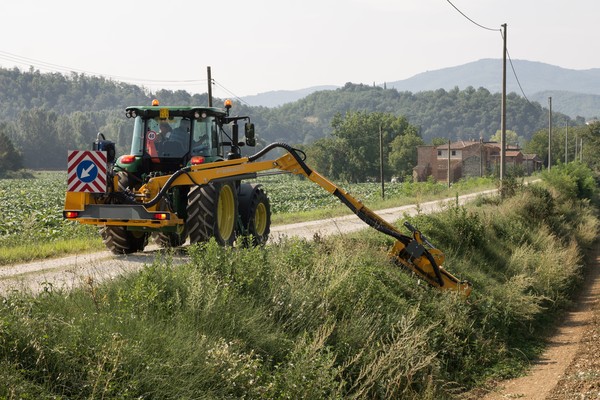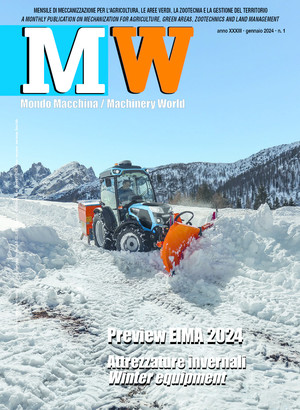
Mechanized maintenance of river banks
The tractor's multifunctionality, and of course, its related implements, involves urban and suburban landscaping manintenance. The bank management of ditches, canals and rivers occupies a prominent role within this activity. In this context, a delicate balance must be maintained between hydraulic safety and environmental protection
Periodic adjustment of the vegetation present on the banks of surface watercourses, whether natural or artificial, is, in fact, the main operation for efficient slope maintenance and safety. Moreover, the mowing of grass and, more generally, of herbaceous and shrubby material must concern the banks and the riverbed of any watercourse. The purpose is to keep the outflow section correct and constant in its conformation and width to avert undesirable narrowing or bottlenecks that could cause dangerous localized flooding in the event of sudden increases in flow.
The most suitable machines for carrying out the maintenance operations described above can basically be grouped into two broad categories, namely models for periodic mowing of the banks, which can be assimilated to brush cutters (but obviously equipped with an articulated arm), and those for cleaning the riverbed, which basically consist of large slotted buckets, fit on the lower profile with a mowing bar with alternating rectilinear motion. Both devices are installed at the end of long articulated booms with two or three sections, which can operate with considerable lateral (as well as rear) overhangs from the tractor, up to 15 m and more.
Structure, mode of operation, and coupling to the tractor
Given the peculiar characteristics of this equipment, the transfer of motion to the working parts can only be hydraulic; indeed, it would be very complicated, and in fact unthinkable, to move the end tools with a combination of shafts, gears, idlers, pulleys, belts, etc. Only in some cases is an assembly of belts and pulleys adopted for the final transmission to the working parts to give greater capacity to absorb the power peaks required when the chopping and cutting tools are overloaded. Conversely, the tractors to be coupled to this equipment differ substantially, as brush cutter booms are usually coupled to agricultural tractors, while mowing buckets constitute the end equipment of excavators, wheel loaders and, more generally, machinery born for earthmoving. However, this is not a categorical classification because multipurpose equipment is also available on the market. Instead, this basic orientation results from the functionality of the two pieces of equipment, as well as from the peculiarities of their modes of operation.
More specifically, in almost all cases, brush cutter arms are mechanically attached to the rear 3-point hitch of the tractor. The rotor, therefore, operates in the rear-lateral position, although some models are connected to the weight carrier, working at the front.
The fully hydraulic operation of this equipment requires very large oil flows, which the original tractor circuits can rarely adequately provide. Therefore, brush cutter arms are almost always equipped with an independent system powered by a gear pump driven by the tractor's PTO. The considerable overhang reached by the shredding apparatus results in a lateral unbalance of the work site, which is appropriately offset by the oil tank (often with a capacity of several tens of liters) placed on the opposite side.
Boom sections can be variously shaped to facilitate the operator's best visibility of the working organ for whatever position it may assume. For maximum functional versatility, the elements of the 3-point hitch of the agricultural tractor, namely the two lower stegs and the third point, are typically characterized by some play in their attachment to the machine body, such that stabilizing tie rods are usually mounted on the two lower arms. This may not be sufficient given the considerable reach lengths for accurate mowing of the brushcutter rotor. For this purpose, some manufacturers offer attachment plates and/or additional anchor turnbuckles to stiffen the attachment of the equipment to the tractor body (often by bolting to the basic structure of the hitch) so as to ensure precise movements in mowing, even at significant distances from the tractor. In other cases, specific bracketing frames are provided to be attached at different points on the tractor body.
On the other hand, the installation of the mowing buckets on the boom of earthmoving machines is less complex since the latter is already usefully prepared for the attachment of different end implements, both mechanically and hydraulically, with a suitable number of sockets to ensure multiple movements. Moreover, the tractor, in this case, has more than sufficient tonnage to ensure the stability of the yard under all operating conditions.
Brush cutter booms
The main differentiation of the available models concerns the articulation of the boom, which can be with two or three sections; the latter type corresponds to greater performance, both in terms of lateral overhang and, more generally, of the operating area around the tractor.
Also, based on the numerous movements that the brush cutter arms can perform, their management is articulated on a series of controls of various types, depending on the models: they range from mechanical management, through flexible cables managed by a group of levers, often of the " dead man's switch" type, to arrive in the more evolved versions at proportional electric controls of the load sensing type on joysticks enabled by CAN-BUS technology. In particular, Ferri of Tamara (FE), for several of its models, offers the "C-Tronic Dual" joystick, by means of which the extension of the first and second sections, their rotation and the tilt of the floating header are controlled proportionally by roller. Then there is a small console equipped with a series of pushbuttons to adjust the rotor's rotation speed, the suspension of the boom and head, and the disconnection of the nitrogen accumulator for automatic return to the working position.
The flail head of the flail mower arms is quite similar to those mounted on the flail mowers, grass shredders, etc. The variables relate to the conformation of the tools and their arrangement on the rotor: in general, these are ranks of bundles or knives of various conformation, mass, and strength, selected mainly according to the consistency of the material to be mowed. As is well known, bundles perform a more vigorous action and are therefore indicated if one has to work predominantly on material of woody origin.
Mowing buckets.
Their main function is largely complementary to cutter booms since they are basically used for removing aquatic vegetation and other spoil in the bed of ditches, canals, and streams and in the shallow areas of their water-level banks. In short, these are wide-mesh slotted or grid buckets, often with a substantial working face (up to 8 m and more), equipped on the lower edge of the spoon with a linear reciprocating oscillating blade cutter bar, usually driven by an orbital motor. The bucket is attached via a sturdy mount (often standardized in size) to the end of the articulated boom of an excavator or wheel loader, although some models may be installed via adaptor frames on agricultural tractors or other equipment carriers. The bucket works in a semicircular motion, as if operating for an excavation, "dredging" the riverbed by parallel sections in a transverse direction to its course, removing plant material cut by the mowing bar. Clearly, all working parts are moved hydraulically, with the absolute necessity, given the operating conditions of immersion in water, that the entire circuitry be watertight. Besides the ability to manage the implement's transverse tilt, some models also have a self-leveling function. Several optional extras increase the functionality of this equipment, such as-for example-the possibility of mounting additional grating bulkheads to increase the volume of loadable material, a flange to offset the bucket from the excavator arm, a leaf spring kit to make the bucket tilt, etc.
Multipurpose self-propelled vehicles
In this varied landscape, some manufacturers have made multipurpose wheeled self-propelled vehicles with articulated and telescopic booms, which can be equipped as an alternative to brush cutters, mowing buckets and numerous other terminal implements. For example, Energreen of Cagnano di Pojana Maggiore (VI) offers the ILF B2000 model equipped with a 6-cylinder diesel engine of no less than 220 hp with a fully pivoting turret, whose hydraulic system makes use of a series of piston pumps and closed-circuit motors for almost 400 l/min total at a pressure of 180-240 bar. The vehicle has 4-wheel steering and can travel at 40 km/h maximum. Its functionality can be expanded to typical agricultural tractor functions by implementing a front kit with PTO and lift, a farming trailer hitch, an air compressor, etc.
Mow: when, where and how much
The periodic mowing of the banks and embankments of ditches, canals, rivers, and, more generally, waterways must satisfy a delicate balance between hydraulic safety and environmental protection. Probably, between a constantly carefully mowed riparian strip and an uncultivated one, the optimum lies somewhere in between; if the former solution undoubtedly allows easy sports activities and serene walks with pets, the latter ensures valuable biodiversity of the watercourse and refuge opportunities for river fauna living and breeding near the bank's edge, i.e., ground-nesting birds, amphibians, small fish, etc.
Mowing should be limited to sections of watercourses within population centers and where specific hydraulic works and accommodations have been installed and carried out, such as expansion tanks, intake or diversion canals, over sufficiently wide swaths to ensure that the watercourse is accessible and can be inspected.
This type of maintenance is basically carried out in spring and summer, partly because at the end of winter, it is crucial to inspect the embankment structures, works, and hydraulic systems, to detect any subsidence or other critical issues so that restoration and repairs can be promptly carried out during the warm season when hydrometric levels are at their lowest.
Usually, under the Italian climate, a first mowing pass is performed by June, followed by another by October-November to totally clear the riverbed section for the next fall and winter floods.
For appropriate protection of nesting birdlife, as well as amphibians and other species present or breeding near the water, it is important to leave a more or less wide strip or alternating stretches of uncultivated vegetation. Periodic maintenance becomes especially important to avert more serious damage, for example, caused by burrows dug by nutria.
Leveling systems
The banks and embankments of watercourses subjected to periodic mowing can sometimes show an irregular surface profile, which forces the operator to make continuous corrections in the trim of the cutting head, in order to avoid damage to the working parts (in case of impact with stones and pebbles emerging from the ground) or to perform a cut that is too high, and therefore inefficient.
This is exceedingly tiring, also affecting the work's productivity, often reducing the forward speed.
It is then very useful to equip the header with leveling systems by which the cutting header becomes floating, thanks in part to the intervention of one or more nitrogen accumulators, which effectively absorb shocks due to irregularities in the profile, both in the transverse direction to the advance and in the longitudinal direction. Even better if such adjustments are of the automatic type so that the tractor driver can focus more attention on the correct direction of the vehicle.
Among the various options available, Orsi di Mascarino of Castello d'Argile (BO) offers the Automatic Leveling System, which minimizes manual intervention by electronically sensing pressure on all movements, adjustable for the threshold of intervention using a potentiometer control, with automatic return to the stored condition after the obstacle has been overcome. This results in a significantly constant cutting height and reduced wear on the machining tools and support slides.








